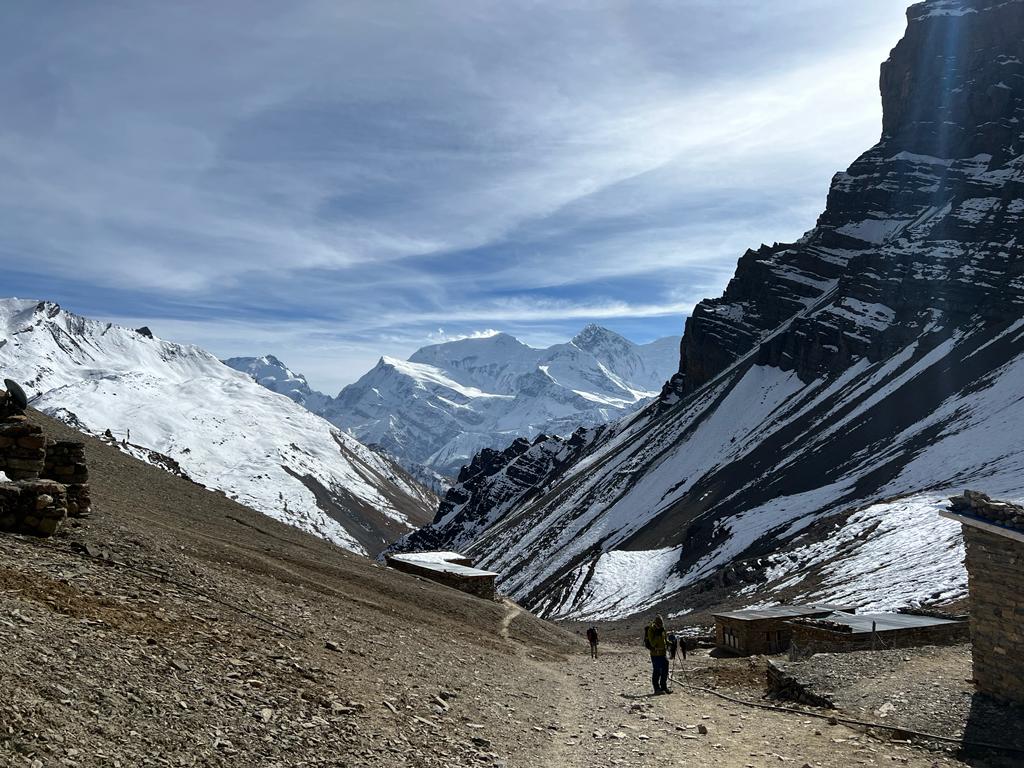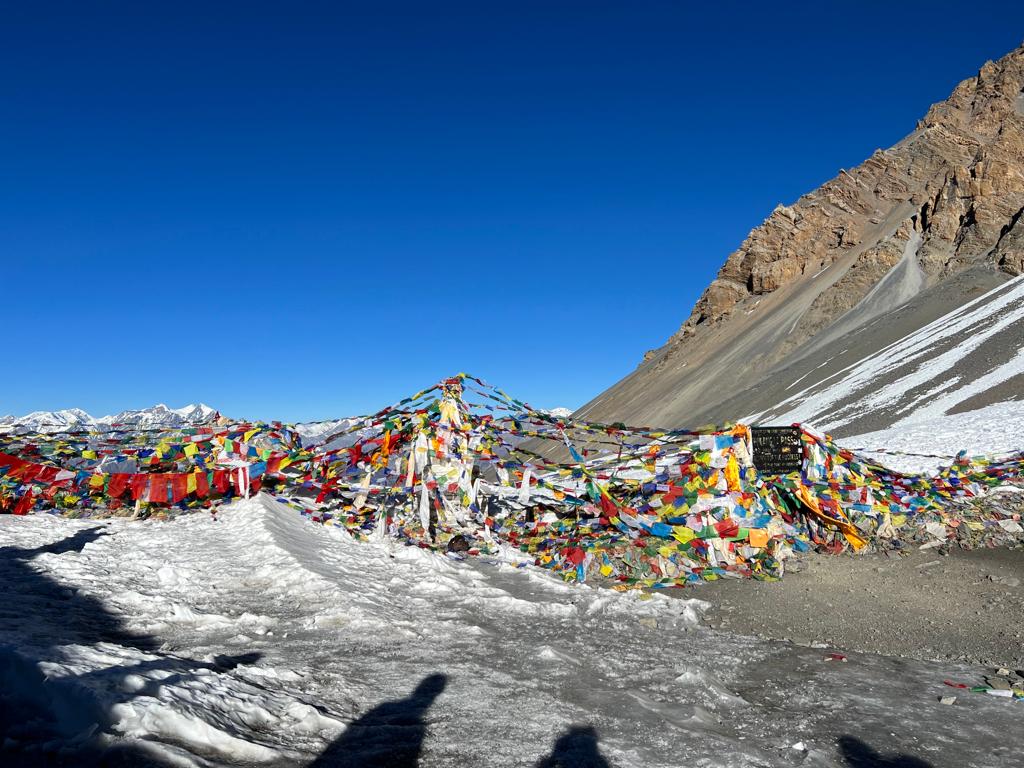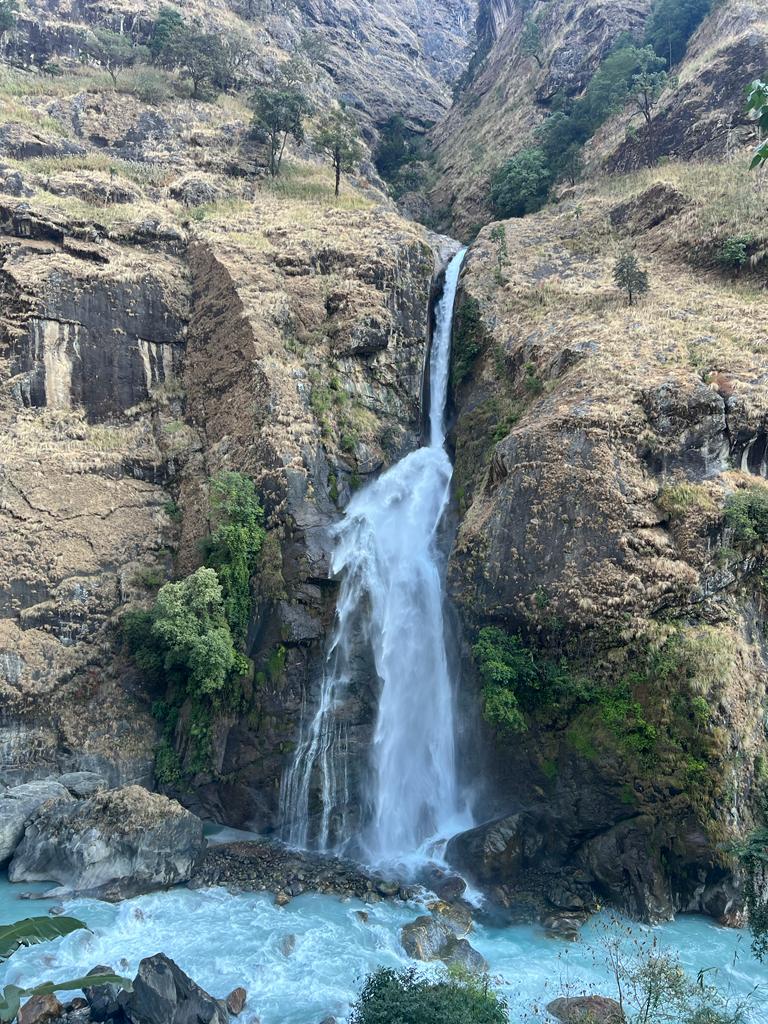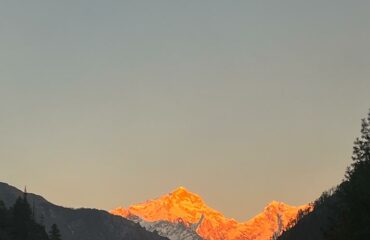Annapurna circuit Trek 21 days
The Annapurna Circuit Trek is a popular hiking trail in Nepal that takes trekkers through a diverse range of landscapes, including lush subtropical forests, arid deserts, and high-altitude plateaus.
-
Vacation Style Trekking
-
Activity Level Trekking
-
Group Size Medium Groups
Annapurna Circuit Trek 21 Days
Annapurna Circuit Trek 21 days Facts:
Destination: Nepal
Max. Altitude: 5416 meters (Thorang La Pass)
Duration: 21 Days
Difficulty: Challenging
Short Hightlights:
- Hike through highest pass in the world-Thorang La Pass at 5416 meters.
- Visit famous Poon Hill trek and Annapurna Base Camp Trek.
- Witness staggering views of Annapurna I, Mt. Dhaulaigir, Mt. Fishtail, Nilgiri, and other peaks.
- Deepest gorge in the world-Kaligandaki Gorge.
- Famous sacred place of Hindu and Buddhist religion-Muktinath Temple.
The Annapurna Circuit Trek is a popular hiking trail in Nepal that takes trekkers through a diverse range of landscapes, including lush subtropical forests, arid deserts, and high-altitude plateaus. The trek circles the Annapurna massif and includes some of the highest mountain passes in the world.
The trek usually starts from the town of Besishahar and goes through several picturesque villages and towns, including Manang, Muktinath, and Jomsom, before descending to the hot springs at Tatopani and ending at the town of Nayapul. The total duration of the trek is usually 15 to 21 days, depending on the itinerary and the acclimatization needs of the trekkers.
The trail passes through several scenic locations, including the Annapurna Conservation Area, the Kali Gandaki Gorge, and the Thorong La Pass, which is the highest point of the trek at 5,416 meters (17,769 feet). Trekkers get to experience the unique culture and lifestyle of the local people, including the Gurung, Thakali, and Mustang tribes. Similarly, the trek requires a good level of physical fitness and endurance, as trekkers will be walking for several hours every day in high altitude conditions. Likewise, altitude sickness can be a serious concern, and proper acclimatization is essential to ensure the safety of the trekkers.
Overall, the Annapurna Circuit Trek is a challenging yet rewarding adventure that offers a unique cultural and natural experience in one of the most beautiful regions of the world.
How difficult is Annapurna Circuit Trek 21 days?
The difficulty level of the Annapurna Circuit Trek 21 days in Nepal can vary depending on several factors such as the trekker’s fitness level, acclimatization, weather conditions, and itinerary.
The trek is considered to be moderately difficult, but it requires a good level of physical fitness and endurance as trekkers will be walking for several hours every day in high altitude conditions. The highest point of the trek is Thorong La Pass, which is located at an altitude of 5,416 meters (17,769 feet) and can be challenging for trekkers who are not well acclimatized.
Altitude sickness can also be a serious concern on the trek, and proper acclimatization is essential to ensure the safety of the trekkers. Trekking in the monsoon season (June to August) can also make the trek more challenging due to the risk of landslides and flooding.
Overall, with proper preparation and planning, the Annapurna Circuit Trek 21 days can be a manageable and rewarding adventure for those who are up for the challenge.
Best time to do Annapurna Circuit Trek
The best time to do the Annapurna Circuit Trek in Nepal is during the Spring (March to May) and Autumn (September to November) seasons.
During the Spring season, the weather is generally dry and clear, and the temperatures are moderate, making it an ideal time for trekking. The blooming rhododendron forests and lush greenery also make the trek more scenic and beautiful.
In the Autumn season, the weather is generally dry and stable, with clear skies and great visibility, which makes it an ideal time for trekking. The temperatures are also moderate, and the crowds are relatively low compared to the Spring season.
Trekking during the monsoon season (June to August) can be challenging due to the risk of landslides and flooding, while trekking during the Winter season (December to February) can be very freezing and snowy, making the trek more challenging.
Overall, the Spring and Autumn seasons are the best times to do the Annapurna Circuit Trek, but it’s important to check the weather forecast and trail conditions before embarking on the trek.
Do I need a permit card to do Annapurna Circuit Trek in Nepal?
To do the Annapurna Circuit Trek in Nepal, you will need to obtain the following permits:
Annapurna Conservation Area Permit (ACAP): The ACAP is mandatory for all trekkers entering the Annapurna Conservation Area. You can obtain the ACAP from the Nepal Tourism Board office in Kathmandu, Pokhara, or at the entry point of the conservation area. The cost of the permit varies depending on the season and nationality.
Trekkers’ Information Management System (TIMS) card: The TIMS card is mandatory for all trekkers entering the Annapurna region. You can obtain the TIMS card from the Nepal Tourism Board office in Kathmandu or Pokhara, or from the Trekking Agencies’ Association of Nepal (TAAN) office in Kathmandu or Pokhara. The cost of the TIMS card varies depending on the season and nationality.
It’s important to note that individual trekkers are not allowed to obtain the permits on their own and must go through a registered trekking agency or a guide. The trekking agency or guide will handle the permit process for you. Adventure Leaders Nepal will help you to get all the required permits you need for this Trek.
Annapurna Circuit Trek 21 days Itinerary
Day 01: Drive from Kathmandu to Besisahar by Local Bus and drive to Dharapani by sharing Jeep. (7-8 hours)
The first day of your trip begins with the drive from Kathmandu for 7-8 hours to Dharapani. Along the highway you can see tranquil farmlands, villages, fast flowing rivers and green hill from the vehicle.
Day 02: Dharapani to Chame (2650m, 6-7hours)
The trail takes you through several small villages and forests, and offers stunning views of the snow-capped peaks.The trek from Dharapani to Chame can take anywhere from 6 to 7 hours, depending on your walking pace and level of Physical fitness. It is a moderately difficult trek with a few steep ascents and descents along the way. Some of the highlights of the trek include crossing the Marshyangdi River on a suspension bridge, passing through the village of Bagarchhap with its unique architecture and prayer wheels, and trekking through the pine and fir forests of the Manang valley. Once you reach Chame, you can explore the village and its surroundings, which include hot springs and waterfalls, or continue on with your trek along the Annapurna Circuit.
Day 03: Chame to Upper pisang (3300m, 4-6 hours)
We trek after taking breakfast early in the morning. The distance between Chame and Upper Pisang is approximately 13 kilometers. The trek takes around 4 to 6 hours and offers stunning views of the Himalayas, with highlights such as crossing the Marsyangdi River, passing through the village of Dhukur Pokhari, and visiting the 16th-century Gompa in Upper Pisang. Overnight stay at Upper Pisang.
Day 04: Upper Pisang to Manang (3540m, 4-5 hours)
The trek is quite easy to moderate today from Upper Pisang to Manang. Hike offers the stunning views of Annapurna massif and other Himalayan peaks. The trail passes through dense forests, valleys, and high-altitude deserts. Similarly, you can experience the lifestyle and culture of local people along the way.
Day 05: Acclimatization day at Manang
Today is important part of trekking in Annapurna circuit. When you are at the height of 3500 meters, your body needs to be acclimatized properly. You can hike around the nearby villages, explore the local culture, enjoy the mountain views, etc. Likewise, we can visit the Rescue Clinic and gain some information regarding the Altitude sickness. Overnight stay at Manang.
Day 06: Manang to Yak Kharka (4018m, 5-6 hours)
From Manang, the walk starts through the alpine forests and high-altitude meadows. The trail is moderate and you can see several tea houses along the way. We will gain the altitude about 600 meters and reach at 4018 meters. The trail goes ascending and descending along the way. Overnight stay at Yak Kharka.
Day 07: Yak Kharka to High Camp (4900m, 3-4 hours)
Today we will trek to High Camp via Thorang Phedi. We will be walking around 5 Kilometers today. The trek typically takes around 3-4 hours and involves a steep ascent, gaining about 700 meters (2300 feet) in elevation. The trek begins with a gradual climb out of Yak Kharka, passing through a rocky and barren landscape. As you continue to climb, the terrain becomes steeper and more challenging, with narrow paths and rocky outcrops. Overnight stay at High Camp.
Day 08: High Camp to Muktinath via Thorang La Pass (5416 meters, 7-8 hours)
The trail takes you through a diverse landscapes, ranging from lush subtropical forests to high-altitude desserts. Likewise, enjoy the views of some of the highest peaks in the world, Annapurna and Dhaulagiri. Crossing Thorang La pass is very challenging tasks that requires stamina, endurance, and proper acclimatization. After passing Thorang La pass, the trail descends to KaliGandaki Valley, the deepest gorge in the world. The trek ends in famous holy place Muktinath. Overall the trail is rewarding journey. Overnight stay at Muktinath.
Day 09: Muktinath to Kagbeni (2804m, 5-6 hours)
The trek from Muktinath to Kagbeni is a scenic and relatively easy walk that takes you through the heart of Mustang region of Nepal. Trail follows the Kali Gandaki river downstream and offers the stunning views of surrounding mountains and landscapes. Likewise, the trail passes through different villages of Mustang, where you can experience unique culture and lifestyle. Overnight stay at Kagbeni.
Day 10: Kagbeni to Marpha (2720m, 5-6 hours)
We will be walking for 5-6 hours today to Marpha. The trail takes you through beautiful Kaligandaki River and Tukuche Village. Similarly, Marpha Village lies at the at the altitude of 2670 meters. Likewise, the village is famous for Apple Brandy. Moreover, you can visit to Apple farm and beautiful monasteries. Overnight stay at Marpha.
Day 11: Marpha to Ghasa (2000m, 4-5 hours)
The trek from Marpha to Ghasa offers stunning views of the Dhaulagiri and Annapurna mountain ranges. You’ll walk through lush forests, past cascading waterfalls, and across suspension bridges over the Kali Gandaki River. Ghasa is the Picturesque village surrounded by beautiful forests. Likewise, it is famous for traditional architecture and you’ll have a chance to explore narrow alleys. Overnight stay at Ghasa.
Day 12: Ghasa to Tatopani (1190m, 4-5 hours)
After having breakfast today we will start your trek to Tatopani. The trek takes around 4-5 hours to complete today. We will start walking down towards the river and again climb the uphill. Similarly, along the way we see charming villages and pass through lush green forests. Overnight stay at Tatopani.
Day 13: Tatopani to Sikha (1935m, 4-5 hours)
The trek is quite easy today. We will be following the trail of Kali Gandaki Valley to Trek to Sikha. Overnight stay at Sikha.
Day 14: Sikha to Ghorepani (2860m, 4-5 hours)
From Sikha the trail is a bit challenging today. We have to walk on unending steep rocky trail. The trail is covered with rocks and ditches. However, beautiful forests of rhododendron forests gives some relief to your challenging uphill climb to Ghorepani. Overnight stay at Ghorepani.
Day 15: Ghorepani to Chuile via Poon Hill (3210m, 5-6 hours)
The day begins with the dazzling sunrise views of mountain peaks from Poon Hill. We will hike to Poon hill from Ghorepani early in the morning around 5 am. After then, our trail takes us towards Chuile via Tadapani. Till Tadhapani the trail is up and down through the green forests. Likewise, from Tadapani we will descend down to chuile to stay overnight.
Day 16: Chuile to Sinwa (2360m, 4-5 hours)
Another adventure to Annapurna Base Camp trek begins from Chuile to Sinuwa. The trek leads us through Chommrong Village. We will cross suspension bridge, terrace farmlands, and small villages of Chommrong. Before reaching to Lower sinuwa, we will again ascend the trail and take some tea break. Upper sinuwa is just 1 km away from Lower Sinuwa. Overnight stay at Sinuwa.
Day 17: Sinuwa to Deurali (3200m, 6-7 hours)
The day is going to be tough one as we will be walking for 6-7 hours today. Trails leads us through the small villages of Bamboo and Dhovan. As we approach Dhovan, beautiful views of Annapurna can be seen from distance. After crossing Dhovan, we will arrive at Himalaya. Similarly, we come across through forests almost all day today. Overnight stay at Deurali.
Day 18: Deurali to Annapurna Base Camp Via MBC. (4130m, 6-7 hours)
One of the most important days of our trek as we will be heading to ABC. The trek begins with the Uphill climb to Bagar. Similarly, from Bagar trail takes us towards Machhapuchre Base Camp. Taking lunch over here at MBC, we enjoy the stunning views of mountain peaks. You can see the magical views of Annapurna range, Mt. Fishtail and Hiunchuli. ABC itself is the amazing place to explore the 365 degree views of towering mountains and glaciers.
Day 19: ABC to Bamboo (2340m, 5-6 hours)
Wakeup early in the morning to enjoy the dazzling golden rays of sun striking at the face of mountain vistas. Enjoy the breakfast witnessing the magical views of mountains and we start out return trek to Bamboo. The trail is all the way descending down following the same route. Overnight stay at Bamboo.
Day 20: Bamboo to Jhinu Danda Hot spring (1780m, 4-5 hours)
Another easy day of trekking all the way down hill to Jhinu Hot Spring. We retrace the same trail and pass the villages to Jhinu Danda. It has natural hot spring where you can take a bath and relax after long trek for 20 days. Overnight stay at Jhinu Danda.
Day 21: Jhinu Danda to Siwa and Drive back Pokhara
The last of the trip isn’t that much of trekking. However we will walk for an hour to Siwai and then take a Jeep and drive back Pokhara for 2-3 hours. Overnight stay at Pokhara.
Cost Includes:
- Airport Pick up and Drop.
- Kathmandu-Besisahar-Dharapani and Siwa-Pokhara transportation costs.
- ACAP and TIMs permit card.
- 21 Days guide and Porter expenses including his meals, accommodations and insurance.
- Accommodations and Meals during the trek. (Set Breakfast, Lunch, Dinner)
- Pokhara Hotel 2 night with BB.
- Pokhara-Kathmandu Tourist Bus ticket.
- Farewell dinner.
- Government Taxes and Local Taxes.
Cost Excludes:
- Personal expenses during the trek like drinks and beverages.
- Evacuation costs in case of emergency.
- Tips to Guide and Porter.
- Lunch and Dinner in Kathmandu and Pokhara.
- Kathmandu Hotel.
Cost Includes:
- Airport Pick up and Drop.
- Kathmandu-Besisahar-Dharapani and Siwa-Pokhara transportation costs.
- ACAP and TIMs permit card.
- 21 Days guide and Porter expenses including his meals, accommodations and insurance.
- Accommodations and Meals during the trek. (Set Breakfast, Lunch, Dinner)
- Pokhara Hotel 2 night with BB.
- Pokhara-Kathmandu Tourist Bus ticket.
- Farewell dinner.
- Government Taxes and Local Taxes.
Cost Excludes:
- Personal expenses during the trek like drinks and beverages.
- Evacuation costs in case of emergency.
- Tips to Guide and Porter.
- Lunch and Dinner in Kathmandu and Pokhara.
- Kathmandu Hotel.
| Departure Dates Confirmed Dates | Trip Status Trip Status | Price (PP) Including Flights | Price (PP) Excluding Flights |
|---|










